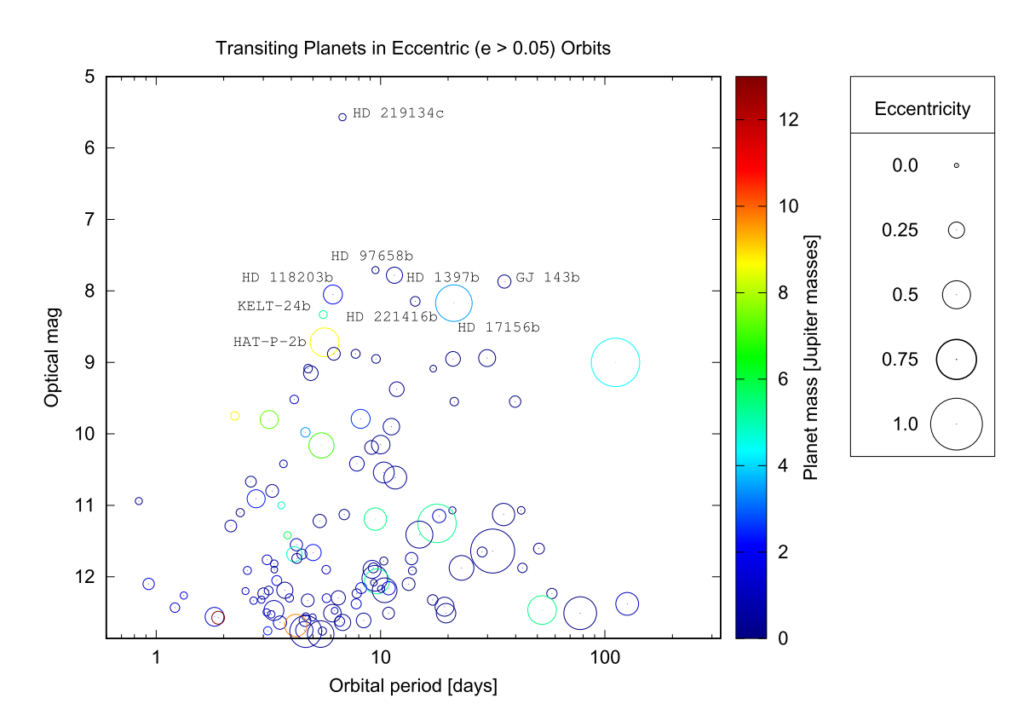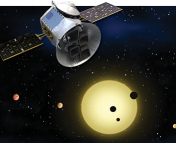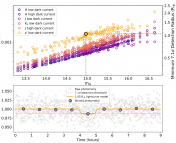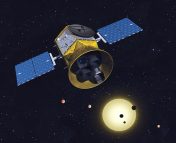Title: TESS Reveals HD 118203 b to be a Transiting Planet
Authors: Joshua Pepper, Stephen R. Kane, Joseph E. Rodriguez et al
First Author’s Institution: Department of Physics, Lehigh University, Bethlehem, USA
Status: S
There are multiple ways to discover an exoplanet. The first exoplanet around a solar type star was discovered by radial velocity measurements, and earned the discoverers’ this year’s Nobel Prize. After the advent of wide field exoplanet surveys, from SuperWASP starting in 2006, to NGTS and TESS, most exoplanets have been discovered using the transit method and confirmed by radial velocity. However, the exoplanet in today’s article, HD118203 b, was detected by radial velocity back in 2006 and has been found to transit 13 years after its discovery.
Radial velocity discovery
HD118203 b was found in 2006 by using the radial velocity technique: measuring the amount the star’s spectrum ‘wobbles’ tugged by its orbiting planet. Spectra are red shifted as the planet tugs its star away from us and blue shifted as the star is tugged towards us over one orbit of the planet. Radial velocity measurements give us the planet’s orbital period as well as its eccentricity and the minimum mass of the planet. The true planet mass depends on the relative inclination between star and planet. 43 radial velocity measurements from ELODIE revealed HD118203 b as an eccentric planet with an orbital period of ~6.13 days, and a minimum mass of about 2 Jupiters (see Figure 1).

While most orbit orientations will produce radial velocity signatures, only a small percentage happen to line up so that we can see the planet pass in front of its star, or transit. Transiting exoplanets block out a small fraction of light giving us the relative radii of planet and star. If a planet transits, this constrains the planet’s inclination and means that the minimum mass from radial velocity is very close to the true mass.
A number of exoplanets discovered using radial velocities have since been found to transit but this process is time consuming for two reasons. First, only a small fraction of exoplanets will actually transit. Second, transits only last a very small fraction of the orbit (usually a couple of hours for an orbit of less than 10 days), so telescopes must stare at a star for long periods of time to discover when the transit actually occurs.
TESS spies a transit (or five)
Transits of HD118203 b were discovered thanks to the ongoing TESS mission. TESS is a space mission which will observe most of the sky, staring at each sector for 28 days, looking for transiting exoplanets. Five transits were automatically identified using the Science Processing Operations Center (SPOC), see Figure 2, and following vetting to check for false positives, it was identified as a promising candidate.

The authors use the exoplanet fitting suite, EXOFASTv2, to fit the planet parameters but first they need to constrain the stellar parameters. They run a preliminary fit to estimate the star’s surface gravity (log(g)), finding that the star is likely a subgiant. A spectral energy distribution (SED) model uses broadband photometry (i.e. the stellar magnitudes measured in different filters) to find the stellar temperature is very similar to the Sun’s but the radius is twice as large. The authors run a full analysis using these stellar parameters as constraints to simultaneously model the ELODIE radial velocities, TESS photometry and fit the stellar parameters using stellar evolution models.
EXOFASTv2 produces two sets of solutions which are consistent with the data: an older (5 Gyr), less massive (1.3 M☉) star or a younger (3 Gyr) more massive (1.5 M☉) star. The authors adopt the older, less massive star solution as the model gives it a much higher probability (89.6% vs 10.4%). Their results are also consistent with two other codes tested.
HD118203 b is an interesting target because it is one of few transiting exoplanets in an eccentric orbit with a bright host star (the 13th brightest of all transiting exoplanets). Figure 3 shows all transiting exoplanets with eccentricities greater than 0.05 and places HD118203 among the brightest host stars. The combination of a relatively short orbital period, a bright host star and an eccentric orbit makes it a good candidate for phase curve observations. Infrared phase curve observations by future space mission JWST, could provide insight into the thermal properties of the planet’s atmosphere.

How many more might TESS find?
HD118203 b is one exoplanet discovered by radial velocity that TESS has observed to transit, but as TESS is observing most of the sky, how many more can we expect? A paper earlier this year, led by one of the coauthors on today’s paper, investigated this question. They considered the transit probability of each radial velocity detected system and how long TESS planned to observe each system in its primary mission. They predict that TESS would observe transits for 11 out of 677 radial velocity planets, but only three would be previously not known to transit. Only 12 radial velocity planets are known to transit, as of March 2019, so this is still a substantial increase. Today’s authors found that HD118203 b was among the planets most likely to be observed transiting (top 2%).
It seems surprising that a relatively large, short period planet took 13 years before it was observed to transit but a key factor is that the transit itself is relatively shallow compared to transit discoveries from ground based wide field surveys of the time. Most transiting exoplanets have also been found around main sequence stars rather than subgiant or giant stars also. Looking forward, it is clear we can expect many more interesting results from TESS, and from photometry and radial velocity measurements working together.





Trackbacks/Pingbacks